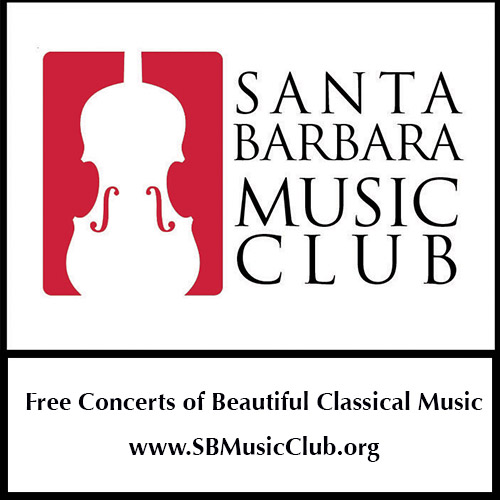
- This event has passed.
Santa Barbara Music Club Free Concerts
March 24, 2018 @ 3:00 am PDT

On Saturday, March 24 at 3 PM, the SANTA BARBARA MUSIC CLUB will present another program in its popular series of concerts of beautiful Classical music. The concert is presented in partnership with the Santa Barbara Public Library and will be held at the Faulkner Gallery in the Downtown branch of the library. Admission is free.
One of the highlights of Santa Barbara Music Club’s concerts is the opportunity for audiences to hear great music from a variety of historical periods, with a diversity of musical forms, performed by excellent artists. This concert features soprano Takako Wakita and pianist Betty Oberacker performing Italian Love Songs by Giovanni Battista Pergolesi, Wolfgang Mozart, Benedetto Marcello, and Ernesto de Curtis. Pianist Natasha Kislenko will close the program with Ludwig van Beethoven’s Sonata #21 in C Major, Op. 53 -“Waldstein” (1804) and Claude Debussy’s La cathedrale engloutie (1910) and L’isle joyeuse (1904).
A leading figure in the rise of Italian comic opera in the 18th century, Giovanni Battista Pergolesi (1710-1736) was one of the most successful and respected composers of his generation. Se tu m’ami (If You Love Me) was first published in the late 1880s by Alessandro Parisotti, in a collection titled Arie antiche. Parisotti collected “antique arias” as part of a 19th century fad for discovering forgotten music from the Classical and Baroque eras. While Parisotti attributed the song to Pergolesi, no early manuscripts of the song have been located, leading some scholars to believe that Parisotti composed the piece himself.
While it may seem odd to see an Austrian composer represented in a set of Italian Love Songs, in the 18th century, Italian opera so dominated the genre that it attracted composers of every nationality. Wolfgang Amadeus Mozart (1756-1791), like many of his contemporaries, was as comfortable writing in the Italian language as in his native German. The Marriage of Figaro, premiered in 1786, was the first of three collaborations with the librettist Lorenzo da Ponte. Deh vieni, non tardar (Oh Come To me, Do Not Delay) is sung by the character of Susanna in Act IV of the opera.
The son of a Venetian nobleman, composer and writer Benedetto Marcello (1686-1739) followed the career path of all Venetian nobles of his time: he was admitted to the Maggior Consiglio (Great Council) of the Republic on December 4, 1706 and, after completing studies in literature and law, served in various magistracies over the next twenty years. Despite earning his living outside of music, he nonetheless was a major influence on Italian musical thought and performance throughout the 18th century, particularly through his psalm settings and cantatas. Quella fiamma che m’accende (That Flame That Ignites My Passion) is one of the latter.
Born in Naples, composer Ernesto de Curtis (1875-1937) studied piano and received a diploma from the Conservatory of San Pietro a Maiella in Naples. He wrote over 100 songs. Non ti scordar di me (Do Not Forget Me) was written in 1912.
Pianist Natasha Kislenko will close the program with Beethoven’s Sonata #21 in C Major, Op. 53 (“Waldstein”) and Claude Debussy’s La cathedrale engloutie and L’isle joyeuse.
Ludwig van Beethoven (1770-1827) was a German composer and performer who so successfully combined tradition, exploration, and personal expression that he came to be regarded as the dominant musical figure of the 19th century. Completed in 1804, the Waldstein Sonata set a standard for piano composition in the grand manner. Dedicated to Beethoven’s close friend and patron Count Ferdinand Ernst Gabriel von Waldstein, it is considered one of Beethoven’s greatest and most technically challenging piano sonatas.
Claude Debussy (1862-1918) was a French composer whose compositional innovations had a profound influence on generations of composers. Composed in 1910, La cathedrale engloutie (The Sunken Cathedral) is a musical depiction of an ancient Breton myth in which a cathedral, submerged underwater off the coast of the Island of Ys, rises up from the sea on clear mornings when the water is transparent. L’isle joyeuse (The Joyful Island) was composed in 1904 and was inspired by Watteau’s painting Embarkation for Cythere.
The mission of the Santa Barbara Music Club is to contribute to the musical life of our community through the following:
Presentation of an annual series of concerts, free to the public, featuring outstanding solo and chamber music performances by Performing Members and invited guests;
Presentation of community outreach activities, including bringing great music to residents of area retirement homes;
Aiding and encouraging musical education by the disbursement of scholarships to talented local music students.
For more information on this or other Santa Barbara Music Club programs and performing artists, visit sbmusicclub.org.


